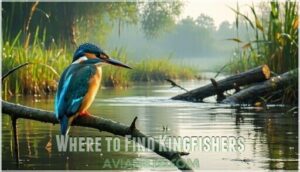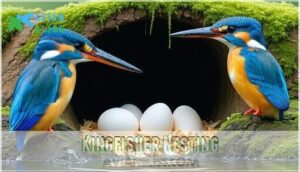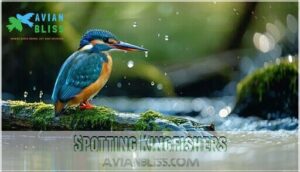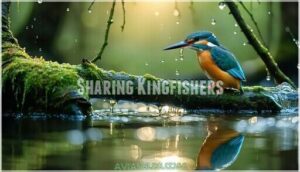This site is supported by our readers. We may earn a commission, at no cost to you, if you purchase through links.
 The best time of day to see kingfishers is early morning, between dawn and 10 AM. These brilliant blue birds are most active when the water’s calm and fish are feeding near the surface.
The best time of day to see kingfishers is early morning, between dawn and 10 AM. These brilliant blue birds are most active when the water’s calm and fish are feeding near the surface.
You’ll have better luck after storms too, since disturbed water brings prey closer to shallow areas. Evening hours before sunset offer another prime window.
Kingfishers prefer quiet spots along rivers and streams where they can perch on overhanging branches. Their fishing success depends on clear water visibility, making still mornings ideal.
Listen for their distinctive rattling call—it’s often your first clue they’re nearby. Weather patterns and seasonal fishing habits reveal even more secrets about their daily routines.
Table Of Contents
- Key Takeaways
- Look for Them Along Rivers and Streams
- Where to Find Kingfishers
- What Do Kingfishers Look Like?
- Kingfisher Feathers
- Kingfisher Locations
- Kingfisher Flight
- Kingfisher Nesting
- Spotting Kingfishers
- Hearing Kingfishers
- Sharing Kingfishers
- Frequently Asked Questions (FAQs)
- What’s the best time of day to see a kingfisher?
- What time of day are belted kingfishers most active?
- What is the best time of day to go birdwatching?
- Where is the best place to find kingfishers?
- What weather conditions are best for kingfisher watching?
- Do kingfishers hunt more actively during certain seasons?
- How does water temperature affect kingfisher feeding times?
- Are kingfishers more visible during overcast or sunny days?
- What time do kingfishers typically return to roost?
- Conclusion
Key Takeaways
- You’ll have the best success spotting kingfishers during early morning hours, between dawn and 10 AM, when the water’s calm and fish are feeding near the surface, making hunting conditions ideal for these brilliant blue birds.
- Listen for their distinctive "chee-chee-chee" rattling calls before you see them; this sharp whistle often signals that a kingfisher’s nearby, so immediately scan overhanging branches and perches in that direction.
- Position yourself along slow-moving rivers and streams with clear water and wooded banks, where kingfishers can easily spot fish from their favorite perches on overhanging branches, dead logs, or power lines.
- Stay patient and maintain at least 15-20 feet of distance from their hunting spots; kingfishers remain motionless for extended periods while hunting, and getting too close will trigger their flight response, ending your viewing opportunity.
Look for Them Along Rivers and Streams
You’ll find kingfishers most often along slow-moving rivers and streams where they can easily spot fish from overhanging branches.
These birds prefer calm waters with clear visibility and plenty of perches, making rivers with wooded banks your best bet for successful sightings.
Head Out Early
Dawn brings kingfisher magic to riverbanks when these vibrant birds are most active.
Early mornings offer the sunrise advantage you need for ideal sightings. Head out just after first light when reduced disturbance creates perfect conditions.
The quiet observation during these morning hours provides perfect light for spotting their brilliant plumage. Best time means better chances.
Kingfishers often arrive at their chosen spots to begin their morning foraging routine.
Listen Out for Their Calls
While kingfishers aren’t the loudest birds, their sharp, shrill whistles cut through morning air like tiny alarms.
During prime hours at dawn, their call frequency increases as they establish territories. Practice call identification by listening for their distinctive "chee-chee-chee" notes.
Understanding differences between songs and calls can greatly improve identification skills.
These alarm calls often signal a bird nearby, so scan overhanging branches in that direction immediately, which can help with call identification and recognizing the distinctive "chee-chee-chee" pattern.
Look Up
Trees and overhead branches reveal kingfisher secrets during morning and afternoon hours.
These aerial hunting specialists choose elevated perches for ideal sightings, making dawn and dusk prime viewing times.
Weather impact affects their flight patterns, so birdwatching tips include:
- Scan telephone wires crossing waterways
- Check dead branches jutting over slow currents
- Watch power lines near fishing spots
Your neck might ache, but kingfisher sightings reward upward observers.
Be Patient
Patience transforms ordinary mornings into extraordinary bird watching adventures.
Kingfishers remain motionless for extended periods while hunting, requiring quiet observation and mindful presence.
Your repeated visits increase sighting chances, especially during dawn when these birds are most active.
Avoid disturbance by maintaining distance during extended viewing sessions.
| Patience Strategy | Time Investment | Success Rate | Best Time |
|---|---|---|---|
| Quick Glance | 5-10 minutes | Low | Any time |
| Short Watch | 20-30 minutes | Medium | Morning |
| Extended Viewing | 1-2 hours | High | Dawn/Dusk |
| Regular Visits | Multiple trips | Highest | Early AM |
The table outlines the patience strategy and its impact on the success rate of spotting kingfishers, with extended viewing and regular visits offering the highest chances of success during dawn or dusk.
Don’t Get Too Close
While patience pays off, maintaining proper distance guarantees you’ll actually see these elusive birds.
Getting too close triggers their flight response, ending your kingfisher sightings before they begin. Respect wildlife by keeping at least 15-20 feet away from their favorite perches. This ethical birding approach protects both birds and viewing opportunities.
- Observe distance: Stay 15-20 feet from perches and nesting areas
- Minimize disturbance: Avoid repeated visits to the same spots
- Photography guidelines: Use telephoto lenses instead of approaching closer
- Birdwatcher etiquette: Move slowly and avoid sudden movements near water
Where to Find Kingfishers
Success in kingfisher sightings starts with understanding their habitat diversity. These brilliant birds prefer slow-moving waters with clear visibility for hunting. Their territory size can span up to two miles along waterways, so you’ll need to cover ground strategically.
Focus your search on these prime locations:
| Habitat Type | Best Features | Why Kingfishers Love It | Viewing Tips |
|---|---|---|---|
| Rivers & Streams | Overhanging branches, shallow areas | Ideal viewing angles for prey | Check meanders and backwaters |
| Canal Environments | Consistent water levels, minimal disturbance | Reliable fishing spots | Walk towpaths quietly |
| Lakes & Ponds | Reed beds, fallen logs | Abundant small fish | Scan edges systematically |
| Winter Habitats | Coastal areas, estuaries | Ice-free water sources | Rock pools hold crustaceans |
Their perching preferences include low branches extending over water. Canal environments offer particularly consistent opportunities since water levels remain stable. During winter months, some kingfishers relocate to coastal areas where they hunt crustaceans in tidal pools.
What Do Kingfishers Look Like?
Spotting a kingfisher feels like discovering a living gemstone along the water’s edge.
Like finding a sapphire dropped by the river gods, every kingfisher sighting feels like pure magic.
These brightly colored birds showcase remarkable plumage iridescence that shifts from brilliant azure to emerald green as light catches their feathers.
You’ll notice their unusually large beaks – black, dagger-shaped tools perfectly designed for fishing.
Their large heads appear oversized compared to their robin-sized bodies, creating a distinctive silhouette.
Size variation exists among species, but most kingfishers you’ll encounter measure about seven inches long.
Males sport completely black bills, while females display orange patches on their lower mandibles.
The bird’s iridescent feathers create stunning color camouflage against shimmering water surfaces.
Orange breast feathers contrast dramatically with the electric blue back, making identification straightforward once you know what to look for.
Juvenile appearance differs slightly – they’re duller with greyish legs instead of bright orange.
Watch for that unmistakable flash of blue streaking along riverbanks.
Kingfisher Feathers
Like sapphire and amber jewels, kingfisher plumage creates stunning displays through feather iridescence.
Their brightly colored feathers don’t rely on pigments alone—intricate feather structure scatters refracted light, producing brilliant blues and greens.
This plumage camouflage helps them blend into watery environments while hunting.
You’ll notice color variation changes with viewing angles and lighting conditions.
Juvenile plumage appears duller than adults, with reduced saturation.
These iridescent feathers shift from azure to turquoise as light hits different microscopic structures within each feather’s keratin layers.
Kingfisher Locations
You’ll find kingfishers across diverse habitats beyond just rivers – they thrive in canal environments, lakes, ponds, and coastal areas.
Each bird claims a territory size spanning up to two miles of waterway, including nearby pools.
Habitat variety matters since some species prefer woodland proximity while others favor open water.
During colder months, many relocate to winter habitats along coastlines where they hunt in rock pools.
Prime birdwatching locations include slow-moving streams with overhanging branches, quiet backwaters, and sheltered estuaries for birdwatching success.
Kingfisher Flight
Once you’ve identified their preferred locations, kingfisher flight patterns reveal their hunting prowess.
Their aerial maneuvers showcase remarkable flight adaptations that make ideal viewing possible during feeding times.
- Flight Speed – Kingfishers reach 25 mph during hunting dives
- Hovering Technique – They brake midair, hovering 3 feet above water
- Diving Mechanics – Wings fold back for streamlined headfirst plunges
- Direct Flight Paths – Quick bursts between favorite perches
- Water-Following Routes – Zigzag patterns mirror river curves
Watch for their distinctive turquoise flash during these bird behavior displays at prime feeding times.
Their agility is enhanced by precise wing adjustments.
Kingfisher Nesting
Underground architects, kingfishers excel at burrow construction during breeding season from February through July.
These sapphire-winged engineers transform riverbanks into subterranean nurseries with remarkable precision.
You’ll find their nest site selection focuses on vertical riverbanks where they excavate tunnels up to three feet deep. Both parents share digging duties, creating secure chambers for their clutch size of typically five to seven eggs.
The female handles the three-week incubation period while males provide food. Fledgling survival depends on parental dedication during nesting.
Never disturb these protected sites—it’s illegal and dangerous since kingfishers aggressively defend their burrows.
Spotting Kingfishers
You’ll need sharp eyes and patience to spot these brilliant blue-and-orange birds along waterways.
Success comes from learning their habits, recognizing their distinctive calls, and checking their favorite fishing perches repeatedly.
Building a Kingfisher Bank
Building an artificial nesting bank transforms your property into prime kingfisher habitat. Strategic site selection along water edges creates ideal conditions for these brilliant birds to establish territories.
Your bank construction project requires specific planning:
- Position the bank 1-3 meters high near slow-moving water with abundant fish
- Use well-drained sandy soil that mimics natural riverbanks perfectly
- Create a near-vertical face allowing kingfishers to excavate tunnels naturally
- Install protective fencing to prevent predator access during nesting season
- Implement erosion control measures ensuring long-term nesting success
Consider adding an electric fence to provide enhanced duckling protection. Proper maintenance strategies guarantee continued kingfisher attraction.
Recognizing Their Calls
Kingfishers produce sharp "tchak, tchak" calls that echo across water during early mornings – the best time for birdwatching.
These high-pitched bird calls carry far, signaling their presence before you spot them. Listen for alarm calls when they’re disturbed or juvenile sounds from nesting areas.
Call identification becomes easier with practice, as vocal range varies between territorial disputes and courtship behaviors.
Call variations help locate these elusive birds.
Watching Their Flight Pattern
During early mornings, you’ll spot kingfishers by their distinctive flight speed and aerial maneuvers.
They zip straight along waterways at the ideal viewing height, rarely deviating from their direct path.
Watch for their unique hovering technique before diving – they’ll pause mid-flight, adjust their diving angles, then plunge headfirst.
Their wingbeat frequency creates a blur of motion.
The best time to track these lightning-fast movements is when they’re actively hunting at dawn.
Checking Favorite Perches
After observing their distinctive flight patterns, you’ll want to focus on their territorial perches.
Kingfishers return to the same hunting spots, making perch availability vital for spotting success.
Check these prime vantage points during early mornings for the best time to observe their fishing behavior:
- Low overhanging branches above slow water
- Dead tree limbs extending over streams
- Exposed roots along muddy riverbanks
- Artificial posts near fishing habitats
- Rocky outcrops providing hunting success platforms
Perch maintenance determines their presence.
Consider the various perch products available for kingfisher habitats.
Hearing Kingfishers
Your ears are your secret weapon for kingfisher success. These birds announce themselves with distinctive calls that cut through morning air like tiny whistles. Listen for their sharp "pee-pee-pee" contact call or the territorial "keee-kee-kee" warning cry during early mornings when they’re most active.
Kingfisher Vocalizations become your roadmap to sightings. The moment you hear that high-pitched whistle, freeze and scan overhanging branches upstream. Call Identification skills develop quickly with practice—their voices are unmistakable once you know them. Birdwatchers can also appreciate the nocturnal acoustic ecology by learning to identify night bird sounds.
| Call Type | Sound Description | When You’ll Hear It |
|---|---|---|
| Contact Call | Sharp "pee-pee-pee" | Flying between perches |
| Territorial | "Keee-kee-kee" | Defending fishing spots |
| Alarm Call | Harsh chattering | When disturbed |
| Courtship | Soft trilling | During breeding season |
| Begging | Rapid squeaking | Young birds with parents |
Birdsong Recognition transforms your birdwatching experience. These Acoustic Behavior patterns reveal their location before you see them. Train your ears to pick out kingfisher calls from the morning Soundscapes of streams and habitats.
Sharing Kingfishers
Building a community around kingfisher conservation starts with thoughtful sharing of your sightings.
When you capture these brilliant birds on camera, you’re creating powerful tools for educational outreach that inspire others to appreciate wildlife.
Here’s how to share responsibly:
- Document the experience beyond photos – Note the time, weather conditions, and specific behaviors you observed during prime viewing periods
- Practice ethical viewing principles – Share locations carefully to prevent overcrowding at sensitive habitats while encouraging responsible birdwatching tips
- Engage your community meaningfully – Post on local birding groups with detailed descriptions of morning encounters and clear skies that enhanced your sighting
Photo sharing becomes most impactful when you describe the patience required and the habitat conditions that made your encounter possible. Habitat loss fragments ecosystems, so sharing habitat details can help others understand conservation needs.
Your enthusiasm for these azure gems can spark curiosity in others, building a network of conservation-minded observers. Through community engagement, we protect kingfisher habitats while fostering deeper connections between people and nature.
Frequently Asked Questions (FAQs)
What’s the best time of day to see a kingfisher?
You’ll have the best luck spotting kingfishers during dawn and dusk when they’re most active hunting.
These birds prefer calm, quiet waters with minimal disturbance, so arrive early for prime viewing chances.
What time of day are belted kingfishers most active?
Like dawn’s first light piercing water’s surface, you’ll spot belted kingfishers most actively during early morning and late afternoon hours.
They’re hunting when fish are near the surface, making these golden times perfect for observation.
What is the best time of day to go birdwatching?
Early morning offers prime birdwatching conditions when species are most active during feeding time.
Dawn’s cooler temperatures encourage bird movement, while reduced human activity creates quieter environments.
You’ll spot more variety during these golden hours.
Where is the best place to find kingfishers?
Hidden aquatic sanctuaries offer your greatest chance of spotting these elusive jewels.
You’ll find kingfishers near slow-moving rivers, canals, and streams with overhanging branches.
Look for clear, shallow waters where fish gather abundantly.
What weather conditions are best for kingfisher watching?
Calm, overcast days with gentle breezes create ideal kingfisher watching conditions.
You’ll have better luck when water surfaces remain still, allowing these birds to spot fish easily and giving you clearer views.
Do kingfishers hunt more actively during certain seasons?
Picture a kingfisher’s electric blue flash cutting through morning mist. You’ll spot them hunting most actively during spring breeding season when they’re catching fish frantically to feed their demanding chicks.
How does water temperature affect kingfisher feeding times?
Water temperature directly influences fish activity levels, which affects when you’ll spot kingfishers hunting.
Cooler water makes fish sluggish, so kingfishers hunt more actively during warmer midday hours when their prey becomes more active.
Are kingfishers more visible during overcast or sunny days?
You’ll spot kingfishers more easily on overcast days when their brilliant blue and orange plumage contrasts sharply against muted backgrounds.
While sunny conditions create harsh reflections that camouflage their iridescent feathers.
What time do kingfishers typically return to roost?
You’ll see kingfishers heading to their roosts during the final hour before sunset.
They typically settle into dense vegetation or riverbank burrows as twilight approaches, usually around 30-60 minutes before complete darkness falls.
Conclusion
Research shows kingfishers succeed in catching fish 60% of the time during prime viewing hours.
Timing matters when you’re searching for these remarkable birds. The best time of day to see kingfishers remains early morning between dawn and 10 AM, when calm waters provide perfect hunting conditions.
You’ll also find success during evening hours before sunset. Remember to stay quiet, listen for their distinctive calls, and position yourself near clear streams.
Patience always rewards dedicated birdwatchers with unforgettable kingfisher encounters.
- https://www.allaboutbirds.org/guide/Belted_Kingfisher/id
- https://en.wikipedia.org/wiki/Kingfisher
- https://www.cam.ac.uk/research/features/why-does-the-kingfisher-have-blue-feathers
- https://canalrivertrust.org.uk/local-to-you?radius=10&postcode=
- https://www.rspb.org.uk/birds-and-wildlife/advice/wildlife-and-the-law/wildlife-and-countryside-act/schedules/










